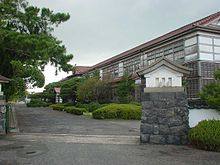Han school
Han schools ( Japanese 藩 校 / 藩 黌 , Hankō , 藩 学 , Hangaku or 藩 学校 , Hangakkō ; German also daimyat school) were the schools of the Japanese fiefdom ( Han ) in the Edo period , which were attended by the samurai until middle age were.
Overview
When the civil war came to an end with the Edo period, the (higher) samurai used their free time to educate themselves. Little by little, schools emerged in many of the 260 Han that existed until the Meiji Restoration . All schools had a name referring to their educational function, which usually ended in -kan ( 館 , for example “institute”) or -jo ( 場 , for example “place”).
The schools had a military branch with horse riding, fencing, archery and a civil branch with the study of Neo-Confucianism, the Chinese classics, with mathematics and natural sciences, especially biology and astronomy. Mathematics was especially cultivated as Wasan .
The Shogunate itself had a school originally founded by Hayashi Razan , which they named Shōheisaka Gakumonjo ( 昌平 坂 学問 所 ), d. H. "School on Shōhei-Hangweg", continued. (See also Yushima Seidō .)
The Han schools were supplemented by private teaching institutions ( 塾 , juku ), especially in the field of medicine.
These educational institutions were the basis for the fact that Japan in the 19th century already had a diverse, well-trained elite, which then quickly caught up with Western science while studying in Europe and the USA.
| year | Seat | school | Japanese | Daimyo family | Koku |
|---|---|---|---|---|---|
| 1636 | Morioka | Sakujinkan | 作人 館 | Nambu | 200,000 |
| 1641 | Okayama | Hanabatakekyōjō | 花 畠 教 場 | Ikeda | 315,000 |
| 1719 | Hagi | Meirinkan | 明倫 館 | Mōri | 369,000 |
| 1736 | Sendai | Yokendo | 養 賢 堂 | Date | 620,000 |
| 1754 | Kumamoto | Jishūkan | 時 修 館 | Hosokawa | 540,000 |
| 1760 | Kochi | Chijukan | 致 授 館 | Yamanouchi | 242,000 |
| 1773 | Kagoshima | Zoshikan | 造 士 館 | Shimazu | 778,000 |
| 1775 | Izushi | Gakumonjo | 学問 所 | Sengoku | 58,000 |
| 1776 | Yonezawa | Kōjōkan | 興 讓 館 | Uesugi | 180,000 |
| 1781 | saga | Kōdōkan | 弘道 館 | Nabeshima | 357,000 |
| 1782 | Hiroshima | Shūdōkan | 修道 館 | Asano | 426,000 |
| 1783 | Nagoya | Meirinkan | 明倫 館 | Tokugawa | 620,000 |
| 1786 | Hitoyoshi | Shūkyōkan | 習 教 館 | Sagara | 22,000 |
| 1786 | Fukuyama | Seishikan | 誠 之 館 | Abe | 110,000 |
| 1789 | Akita | Meitokukan | 明 徳 館 | Satake | 205,000 |
| 1791 | Wakayama | Gakushūkan | 学習 館 | Tokugawa | 555,000 |
| 1792 | Kanazawa | Meirinkan | 明倫 館 | Maeda | 1,027,000 |
| 1799 | Fukuoka | Shukenkan | 修 猷 館 | Kuroda | 520,000 |
| 1799 | Wakamatsu | Nisshinkan | 日新 館 | Matsudaira | 555,000 |
| 1799 | Hikone | Kōdōkan | 弘道 館 | Ii | 240,000 |
| 1805 | Tsuruoka | Chidōkan | 至道 館 | Sakai | 138,000 |
| 1838 | Mito | Kōdōkan | 弘道 館 | Tokugawa | 350,000 |
| 1856 | Tokushima | Nagakukan | 長久 館 | Hachisuka | 258,000 |
| 1857 | Ōita | Yūenkan | 遊 焉 館 | Matsudaira | 22,000 |
Individual evidence
- ↑ Yanagimachi Takanao: Edojidai-kan. Shogakukan, 2002. ISBN 4-09-623021-9 .
- ^ E. Papinot: Historical and Geographical Dictionary of Japan. Reprinted by Tuttle, 1972 edition of 1910 edition. ISBN 0-8048-0996-8 .


